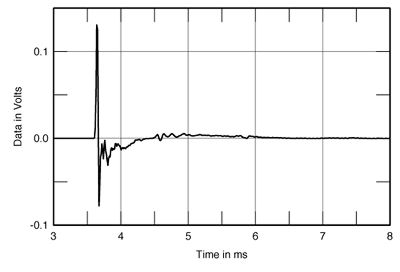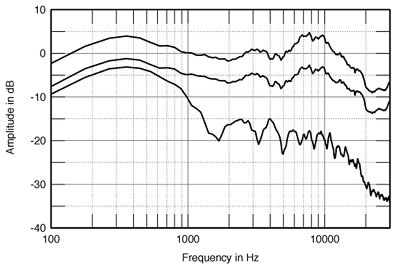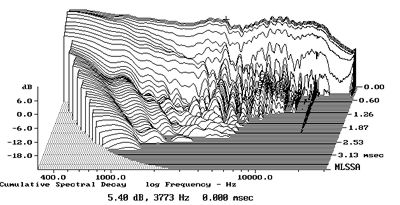| Columns Retired Columns & Blogs |
Apogee Stage & Mini-Grand loudspeakers 1990 Measurements
Sidebar 1: 1990 Measurements
After Dick delivered the review copy to me, Tom Norton and I quickly carried out a set of measurements to see if the Stage had any other idiosyncrasies other than the ones Dick had uncovered. Looking first at the speaker's impedance as measured with Stereophile's Audio Precision System One, fig.5 shows the impedance with the HF control set to Normal, fig.6 with it set to High. Both average around 3 ohms, with a slight rise at 400Hz due to the crossover. A comparison of the shapes of the two curves suggests that the High position is the natural output of the ribbon drive-unit, the Normal position applying a degree of EQ. Note the slight wrinkles in the bass in both phase and magnitude plots in figs.5 and 6. These reveal the woofer panel's "drumskin-resonance" tuning, which appears to lie at two discrete frequencies, 47Hz and 37Hz.

Fig.5 Apogee Stage, electrical impedance (solid) and phase (dashed) with HF switch set to "Normal" (2 ohms/vertical div.).

Fig.6 Apogee Stage, electrical impedance (solid) and phase (dashed) with HF switch set to "High" (2 ohms/vertical div.).
Turning to the time domain, as assessed using the DRA Labs MLSSA FFT analyzer, the Stage's impulse response (with the speaker raised some 24" to push reflections of the pulse from the floor back in time) can be seen in fig.7. Examination of the individual drive-units reveals that though the mid/HF ribbon is connected with the correct polarity, the woofer is actually inverted, a positive-going pulse producing a negative-going acoustic output, indicating a second-order crossover.

Fig.7 Apogee Stage, impulse response on tweeter axis at 48" (5ms time window, 30kHz bandwidth).
The MLSSA system allows you to window just the portion of the impulse response that is free from room reflections; carrying out a Fast Fourier Transform (FFT) on that windowed section gives the speaker's anechoic frequency response (with a frequency resolution inversely proportional to the length of the window; ie, a 5ms time window equates to 200Hz resolution). Fig.8 shows the individual responses of the two ribbons, taken at a 48" measuring distance midway up the treble ribbon axis. Level matching between the two on this graph can only be approximate, but it can be seen that the treble ribbon handles pretty much everything above 500Hz. The woofer ribbon seems remarkably free of breakup problems above its crossover point, this undoubtedly contributing to the speaker's clean midband reproduction. A slight bit of woofer nonsense can be seen just above 3kHz, but as this is 25dB down, it should be inconsequential. The treble ribbon, however, seems a little lively in the mid-treble, with then a gradual rolloff above 15kHz on this axis. (The HF control was set to Normal for this and the next measurements.)

Fig.8 Apogee Stage, anechoic responses of woofer and tweeter on tweeter axis at 48", corrected for microphone response.
With all of the midrange and treble handled by the narrow, 5/8"-wide ribbon, it is not surprising that the Stage offers basically good horizontal dispersion. Fig.9 shows five anechoic responses (taken at a 48" distance) ranging from 15 degrees off the ribbon axis on the treble side (front) to 15 degrees off the ribbon axis on the woofer side (rear). The central response is on the ribbon axis. Note that the smoothest response through the treble, or at least the one without a significant suckout, is obtained off-axis on the woofer side. This will tend to make positioning of the Stages rather critical if the listening room's sidewalls are either too close or too reflective. Looking at the off-axis response on the treble-ribbon side, it can be seen that the 15 degrees off-axis response—what a listener would hear with the speakers firing straight ahead—can have its exact mid-treble to high-treble balance adjusted by toeing the speakers in slightly. But toe them in too much, so that the listener is facing the ribbon, and, as DO found, the highs become a little excessive in level, even with the switch set to Normal.

Fig.9 Apogee Stage, horizontal response family at 48", normalized to response on-axis midway up panel, from back to front: differences 15 degrees and 7.5 degrees off-axis on woofer ribbon side, reference response; differences 7.5 degrees and 15 degrees off-axis on ribbon tweeter side.
The Stage has a much narrower dispersion in the vertical plane, as can be seen in fig.10. The central curve is the same on-axis response at 48" as in fig.9. The frontmost curve, however, was taken with the microphone still at a 48" distance but now some 8" above the top of the baffle, this axis approximately representing a standing listener at the back of a typical listening room. The treble ribbon shelves down by a severe 12dB or so on this axis: it is essential, therefore, for Stage owners to be seated so that their ears are level with the midpoint of the ribbon if they are to get a full measure of treble. The rearmost curve in fig.10 shows the effect of switching the HF control to High, the entire region above 8kHz then lifting by 2dB or so.

Fig.10 Apogee Stage, anechoic response midway up ribbon axis at 48", corrected for microphone response, with HF switch set to "High" (top), set to Normal (middle), and at 48" with mike 8" above baffle top (bottom).
To get an idea of how the Stage would sound in a room, I averaged the five curves in fig.9 to give the speaker's overall anechoic response in the 30 degrees window encompassing a typical listener, resulting in the curve to the right of fig.11. To the left of fig.11 is the Stage's bass response measured in the nearfield, with the microphone almost touching the protective mesh over the diaphragm. Above the dramatic rise in the bass (which will be compensated for in-room by the usual dipole cancellation as the back wave increasing wraps around to the front with decreasing frequency), the speaker's sound can be seen to be characterized by a gently sloping trend from around 80Hz to 8kHz. Beautifully smooth, this will contribute both to the speaker's slightly mellow tonality and to its seamless presentation of midrange sounds.

Fig.11 Apogee Stage, anechoic response averaged across 30 degrees horizontal window, corrected for microphone response, with nearfield LF ribbon response plotted below 300Hz.
It's a matter of conjecture how the woofer's highish-Q drumskin resonance, which leads to the 17dB boost at 45Hz, will be perceived subjectively. On small-scale chamber-music and human-voice recordings, it is unlikely that it will be directly excited, allowing the speaker's smooth, uncolored midrange to be perceived in all its glory. But on full-scale orchestral recordings and rock music, it will add majesty in the first instance but a ponderous quality in the second. It will also make the Stage intolerant both of amplifiers lacking control in the bass and of cables that themselves are rather "slow," subjectively.
In the treble, the Stage has some measured liveliness that will add a degree of treble brashness: DO did note "a residual artificiality in the treble—sort of a zippy aftertaste." Listening to the Stages myself, this character was definitely noticeable and reminded me, though to a lesser degree, of the treble featured by the ribbons of both the Celestion 3000 (reviewed in May) and the Carver Amazing loudspeaker (reviewed in February), where a basically uncolored treble was overlaid with added brightness due to high-frequency ribbon resonances. (I know it's unwise to stretch analogies too far, but I can't help thinking of this character as a kind of "crinkly" noise that one associates with aluminum foil.)
The cumulative spectral-decay plot for the Stage on the ribbon axis (fig.12—ignore the ridge at 15.75kHz, which is due to the microphone picking up the computer-monitor line whistle), though featuring a clean initial drop of the impulse, also shows some residual hashiness between 3kHz and 10kHz. I understand that the degree of this treble hash is proportional both to the mass of the ribbon and to the degree of its self-damping—it is therefore naïve to think, as I once did, that a ribbon is inherently resonance-free. This slight treble hashiness will also make the speaker less tolerant than some of ancillary cables and amplifiers with a similar tonal signature.

Fig.12 Apogee Stage, cumulative spectral-decay plot at 48".
With one exception, there are no real surprises in these measurements. The exception, however, is important in that though the midrange measures as being commendably smooth, if a little downtilted, nothing prepared me for the degree of tonal versimilitude—read musical accuracy—with which the pair of Stages, optimally set up, reproduced recordings with which I was familiar.—John Atkinson
- Log in or register to post comments




































